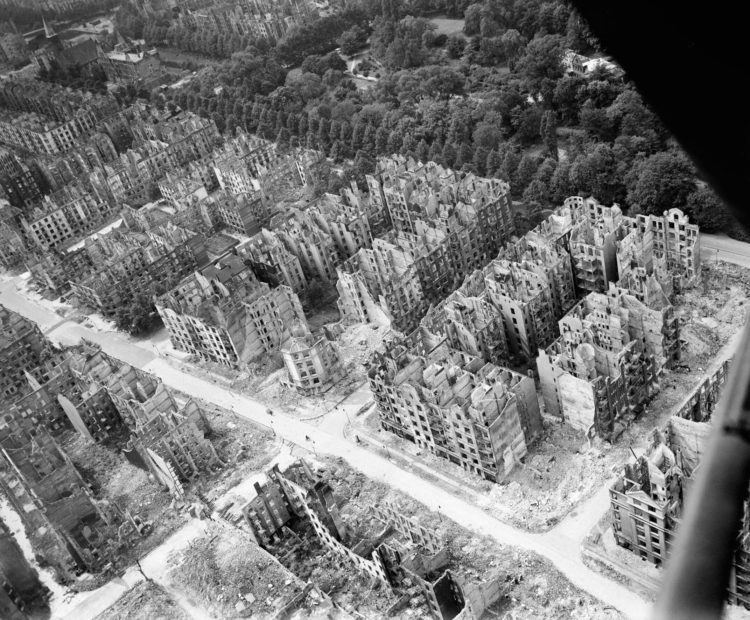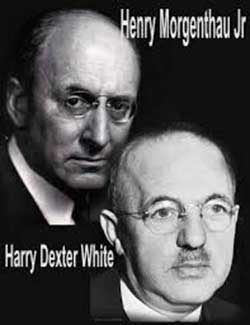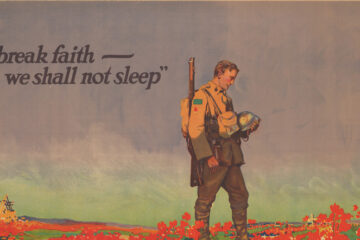Horrific War, Calamitous Peace

by Nelson Rosit
Hellstorm: The Death of Nazi Germany, 1944—1947
Thomas Goodrich
Introduction
I WAS FLATTERED when asked to review Thomas Goodrich’s book Hellstorm. Though first published in 2010 it has recently come out in paperback and Kindle editions and deserves wider notice. That said, I knew this would not be an easy book to read and review.Hellstorm chronicles the atrocities and deprivations visited upon Germany from 1944 to 1947. Though much of the story will be familiar to serious students of World War II, the author has also included some new primary-source material. The bibliography shows that Goodrich has accessed most of the older major works in this field, making Hellstorm a well-researched compendium. So, if you have not read Bacque, Sajar, Keeling, et al. you will find them quoted and footnoted here.[1]
In addition to hundreds of footnotes the book contains two maps, always a plus, sixteen pages of photographs, and a useful bibliography and index. If fault can be found, it would be that Goodrich seems to have completed his research by 2000, so none of the more recent historiography has been included. Also, there are places in the narrative where the events described are not assigned a date and location, making the chronology a bit unclear.
These are minor criticisms, however, because it is not simply as a piece of historiography that Hellstorm finds its power, but as a gut wrenching, heart rending story of human suffering and the malice that produced that misery.
Synopsis
Prologue: Right from the start Goodrich grabs the reader by the lapels and shakes him. He starts by describing the fate of the East Prussian village of Nemmerdorf. In October 1944 it became the first town in Germany proper to be overrun by the Red Army. Soviet troops went into a blood frenzy of rape, torture, and murder.
The author makes it clear that by 1944 the war aims of the Allies was not just the defeat of the German armed forces, nor even the destruction of the National Socialist regime, but rather, “nothing less than the utter extinction of the German nation” (6). Why the genocidal intent?
Goodrich suggests that, in large part, this genocide was the culmination of an eleven-year propaganda campaign against Germany lead mainly by American Jews. International Jewry had declared war on Germany in 1933 by instituting economic sanctions as well as the above-mentioned propaganda offensive. The author quotes from Theodore N. Kaufman’s 1941 book Germany Must Perish! “Germany must perish forever! In fact — not in fancy . . . by preventing the people of Germany from ever reproducing their kind” (7). He also cites Ben Hecht’s 1944 A Guide for the Bedeviled in which Germany and Germans are compared to a cancer which must be destroyed.
On September 15, 1944 President Franklin Roosevelt converted such hate-filled rants into official policy by endorsing the Morgenthau Plan. Named for Secretary of the Treasury Henry Morgenthau and developed by his chief lieutenant Harry Dexter White (both Jews), this plan envisioned reducing the postwar population of Germany by two-thirds mainly through the starvation of 50 million men, women, and children. Winston Churchill also signed on to the Morgenthau Plan.
To the east, Ilya Ehrenburg, “perhaps the most influential Jewish writer anywhere in the world,” was advocating German genocide via articles in Pravda, Isvestja, and Red Star as well as in millions of leaflets distributed at the front. “The Germans are not human beings. . . . Kill, Red Army men, kill! No fascist is innocent, be he alive, be he as yet unborn” (10).
Chapter 1 covers the terror bombings conducted by American and especially British air forces. This campaign begun in July 1943 with attacks on the port city of Hamburg that left, “750,000 homeless [and] an estimated 60,000 to 100,000 dead, mostly women and children” (14). Called by various names — area bombing, carpet bombing, saturation bombing, and unrestricted bombing — the indiscriminate destruction of urban areas could more accurately be described as terror bombing.
The leading architect of terror bombing was Chief of British Bomber Command Arthur “Bomber” Harris. Postwar assessments by military and political leaders as well as historians have led most to agree that, in contrast to strategic bombing of military targets and production and transportation facilities, bombing of residential areas and cultural monuments was ineffective. While causing massive devastation, it failed to break civilian morale.
Chapter 2 deals with the issue of POWs on the Eastern Front. Much has been written about the poor treatment received by captured Soviet (but not Western) soldiers. But Goodrich makes the point that Stalin, “refused to sign the Geneva Convention on prisons of war or the Hague Treaty on land warfare” (49). With no assurance of humane treatment for their own troops Germans gave little quarter. Unfortunately, massacres of prisoners on both sides began early. For instance, on July 1, 1941 160 captured Germans were shot or bayonetted in Broniki, Ukraine.
Chapter 3 continues to chronicle events on the Eastern Front as the Soviets advance into Germany. Rape, murder, looting, and destruction accompany the Red Army. “Kill them all, men, old men, children, and the women, after you have amused yourself with them!” urged Ilya Ehrenberg (81). One German boy recalled that in his town, “everyone wearing anything military — a military coat, for example … [was] shoved against a wall and shot” (86). Also in this chapter Goodrich recounts the disaster that befell the refugees trying to flee west by sea. On the night of January 30, 1945 the Wilhelm Gustloff was steaming west on the Baltic Sea, grossly overloaded with 8,000 women, children, and wounded soldiers. Goodrich skillful describes the scene.
That black stormy night, as she struggled through high winds and heavy, ice-filled waves, the Gustloff’s ventilation and plumbing systems failed utterly. Strained beyond its limits, the tightly-sealed ship filled with a hot, nauseating stench of urine, excrement, and vomit. The groans and screams of severely wounded soldiers and the wails of separated families added to the ghastly horror. But the worst was yet to come. At approximately 9 P.M., three heavy jolts rocked the passengers on the Gustloff. (89)
The ship had been torpedoed by a Soviet sub. Goodrich gives a figure of roughly 7,000 men women and children lost.[2]
Chapter 4 gives an account of the Yalta Conference of February 1945. For seven days the leaders of the Big Three — Britain, the US, and the USSR — met in Crimean Black Sea resort. This conference confirmed the decision made by Roosevelt and Churchill at Casablanca in 1943 to accept nothing less than unconditional surrender from Germany thus insuring that the Germans would fight to the bitter end. Goodrich notes that the US President “was a staunch supporter and admirer of [Stalin] and defended him at every turn” (98). It was FDR who gave the Soviet dictator the moniker “Uncle Joe.”
Most of this chapter is devoted to describing the holocaust of Dresden. The city, which had been spared up to this time, was obliterated in mid February 1945 by Allied air attacks. The author gives six compelling reasons why Dresden should have been spared the destruction visited upon Hamburg and other German cities. But spared it was not.
On February 13 and 14 the magnificent Baroque city was bombed to rubble. Then thousands of incendiary bombs were dropped igniting the debris to create huge fire storms. “[T]he International Red Cross estimated that 275,000 had died … other estimates that place the death toll at 300,000 to 400,000 may well be closer to the mark” (123). After the horror of Dresden a few Allied political and military leaders raised protests, but “the air terror continued unabated” (125).
Chapter 5 returns to the plight of those fleeing the Soviet advance. After 150 pages of death and destruction the reader may think he has become inured to descriptions of violence. Then Goodrich recounts the shocking story of Neustettin. After the Red Army overran the city in February 1945 2,500 girls of the Reich Labor Service were killed, many after the most gruesome torture imaginable.
Chapter 6 deals with the conduct of Allied soldiers in the West. Their behavior was not nearly as bad as the Soviets, but the GIs did “’their share of looting and raping’ a US sergeant admitted” (169). Even more serious than looting and rape were the “large number of captured or surrendered Germans [who] were simply slaughtered on the spot” (170). Fortunately, these were the exceptions rather than the rule and Goodrich concedes that “the average GI and Tommy comported himself amazingly well” (170).
Chapter 7 describes the Battle of Berlin, the desperate, heroic, ugly, and hopeless defense of the German capital.
Chapter 8 covers a number of topics: the concentrations camps in the West, the fate of German POWs and civilians in the East, and the treatment of foreigners who supported or collaborated with the Germans.
When the concentration camps in western Germany were captured Allied soldiers were greeted by the sight of thousands of emaciated bodies, living and dead. With the breakdown in production and distribution of food, fuel, clothing, and medicine, “thousands of camp inmates swiftly succumbed in the final weeks of the war to typhus, dysentery, tuberculosis, starvation, and neglect” (230). The Allied forces blamed the camp guards for these conditions and shot most of them on the spot. At this point of the war, however, many of the guards were ordinary German soldiers assigned to the camps to keep some semblance of order until Allied troops arrived.
The surrender of German forces in the spring of 1945 did not bring peace nor stop the killing. In Czechoslovakia German civilians and POWs were subjected to savage reprisals. Almost all Germans, many from families who had been there for centuries, were expelled from their homes. Over 200,000 were killed, many tortured to death. Similar scenes, on a lesser scale, were played out in Rumania, Hungary, and Yugoslavia. In France, 100,000 French citizens who had collaborated with the Germans were murdered.
At the end of the war over five million Soviet citizens — POWs, Cossacks, foreign workers, veterans of Vlasov’s German/Russian army — fell into the hands of the western Allies. To appease Stalin, Operation Keelhaul was implemented to forcibly return these millions to the USSR to face execution or years of slave labor. Operation Keelhaul became Operation Prevarication as the War Department solemnly proclaimed, “The United States Government has taken a firm stand against any forced repatriation and will continue to maintain this position. … There is no intention that any refugee be returned home against his will” (251).
Meanwhile General Eisenhower was circumventing the Geneva Convention by designating captured German soldiers as DEFs, Disarmed Enemy Forces rather than POWs who would be accorded certain protections under international law. As a result, the surrendering Germans were imprisoned in huge open-air enclosures without shelter, and with little food, water, or medical care. Hundreds of thousands died of exposure, starvation, dehydration, and disease. Probably close to one million German prisoners died in American and French camps. “And thus, in ‘peace,’ did ten times the number Landsers die than were killed on the whole Western Front during the whole of the war” (260).
“’These Nazis are getting a dose of their own medicine’ a prison commandant reported proudly” (255). At the same time the International Red Cross reported that ninety-nine percent of American POWs held by Germany survived the war and returned home safely.
Chapter 9 begins with the German unconditional surrender on May 8, 1945. One phase of the war was over. Incredibly, “the worst yet lay ahead. . . . The war against Germany continued unabated” (279). Goodrich points out that the Morgenthau Plan was never officially repudiated and what might be called the Modified Morgenthau was implemented. “‘Most children under ten and people over sixty cannot survive the coming winter,’ one American admitted in October 1945” (289). A few US elected officials protested the treatment of Germans, but the great humanitarian Eleanor Roosevelt declared after a fact-finding tour that conditions in Germany were “tolerable” (292).
Chapter 10 surveys the de-Nazification process instituted after the war. This process involved imprisonment, interrogation, and punishment. Interrogation was often accompanied by beatings, rapes, and even more extreme torture. Few failed to confess to whatever they had been accused of while often implicating others as well. “One man opposed to the vengeance-minded program was George Patton. ‘Evidently the virus started by Morgenthau and [Bernard] Baruch of Semitic revenge against all Germans is still working,’ wrote the general in private” (299).
Twice in the book Goodrich mentions that in immediate postwar Germany the Salvation Army was, “one of the few relief organizations that dared face and fight the incredible suffering, regardless of the Allied political pressure.” (318). Although the Salvation Army was hardly able to “make a dent” in the desperate conditions these efforts might be something to keep in mind when you hear the bell ringers around Christmas time.
Chapter 11 covers the expulsions of over twelve million Germans from Prussia, Pomerania, and Silesia. After the war the USSR would claim a bit of East Prussia, the rest of the territory was awarded to Poland. The Germans, whose ancestors had lived in these lands for many centuries, were forced to flee west. Without adequate food, clothing, or shelter, exhausted and hungry, these hapless refugees were robbed, beaten, raped, and murdered by Russian soldiers, Polish militia men, and gangs of Gypsies and Jews. It was, “the greatest death march in history, [and] it was preordained that millions would never survive the trek” (334).
About two million eastern German expellees, mostly women and children, died. Another one million ethnic Germans expelled from Czechoslovakia, Hungary, Rumania, Bulgaria, and Yugoslavia also died. Four million more Germans were sent east and disappeared into the gulags. Unbelievably, it appears that, “far more Germans died during the first two years of “peace” than died during the previous six years of war” (344).
Epilogue: The author suggests that the one thing that saved Germany from total postwar destruction was the beginning of the Cold War. By the late 1940s “Great Britain and the United States were more intent on erecting a bulwark against Soviet expansion than in flailing a fallen enemy even further” (354).
Goodrich ends the book by saluting the German people’s will to live manifest in their postwar economic miracle. Yet he also notes that the propaganda campaign against Germany has continued — a psychological and political necessity for the victors to justify their wartime and postwar policies.
Conclusions
Hellstorm is revisionist history in the most basic definition of the term “revision” — to look at again. Seven decades after the end of World War II the standard narrative still reads like a morality play — the forces of good fought and triumphed over the forces of evil. Whenever history is written in such simplistic terms the reader should know that much of the story is missing. Building on earlier efforts, Hellstorm provides some of the missing pieces of the story.
This reviewer can remember when James Bacque’s Other Losses came out in 1989. It caused a minor stir. It contained evidence that perhaps one million Germans died in captivity in the West. It was released by a major Canadian publisher. It was reviewed by several mainstream publications. And, in that pre-internet age, it was available on the shelves of chain bookstores.
Yet Other Losses shows how difficult it is for any single book, no matter how significant, to change public perceptions of World War II formed by decades of incessant propaganda. Jews were the real victims of the war, and whatever losses the Germans may have suffered were their own fault.
The need for a more balanced view of the war and the need to interpret National Socialist Germany within a historical perspective is why Hellstorm is an important book. More such books need to be written. The suffering of the German people needs to be acknowledged. People of European extraction everywhere should see that the children burned alive or crushed under rubble were our children. The women beaten and raped were our women. The young soldiers summarily executed were our boys.
After seventy years, the denials and hypocrisy of the war and postwar years need to be recognized. For example, today America is fighting a War on Terror, yet terror — the killing of the innocent for military and political ends — was a major tactic of the Allies during World War II.
In 1984 Jewish author and media personality Studs Terkel published a best-selling oral history entitled The Good War. There was absolutely nothing good about World War II. It was a tragedy for our peoples and civilization.
William Faulkner wrote, “The past is never dead. It’s not even past.” Thus it is with World War II. The war is still being fought. It is a psychological war that heaps shame and guilt on Germany, and ironically, on her opponents as well to the extent they shared Germany’s race and culture. The war ought to be seen as an internecine conflict, the result of a failure of statesmanship by both Anglo-American and German leaders. As Patrick Buchanan wrote, it was The Unnecessary War.[3]
An optimist might see the tide beginning to turn. In the past several years a number of mainstream books have been published seeking to present a more impartial view of the wartime and postwar suffering.[4]
This is much more than just an issue of nuanced historiography. The narrative of World War II continues to be used as a propaganda weapon to demoralize the West. The effort to historicize World War II should continue. Hellstorm is part of that effort.
Hellstorm and other books by Thomas Goodrich are available from Cosmotheist Books.
Notes
[1] Among the important works in this field cited are: James Bacque, Other Losses: An Investigation into the Mass Deaths of German Prisoners at the Hands of the French and Americans after World War II (Toronto: Stoddart Publishing Company, 1989); Guy Sajar, The Forgotten Soldier (New York: Harper and Row, 1967); Ralph Franklin Kelling, Gruesome Harvest: The Allies’ Postwar War against the German People (Torrance, CA: Institute for Historic Review, 1992).
[2] The loss of life was probably even greater than the author states. More recent research reveals that the Gustloff may have had over 10,000 abroad and approximately 9,400 were lost including 5,000 children. That would be six times the loss of life from the sinking of the Titanic making it the greatest maritime disaster in history. See Cathryn J. Prince, Death in the Baltic: The Sinking of the Wilhelm Gustloff (NY: Palgrave MacMillan, 2013).
[3] Patrick J. Buchanan, Churchill, Hitler, and the Unnecessary War: How Britain Lost its Empire and the West Lost the World (NY: Crown Publishers, 2008).
[4] In addition to the Prince book cited above see: Keith Lowe, Savage Continent: Europe in the Aftermath of World War II (NY: St. Martin’s Press, 2012).http://www.theoccidentalobserver.net/2014/10/horrific-war-calamitous-peace/
* * *
Source: Occidental Observer via Culture Clash







The Jewish-controlled Allies were nothing short of beastly to the German people. And they project their awful crimes onto the Germans!
Hello FBI and Canadian homosexual Jew
Brian Lambsky! I hate all Jews everywhere!
I hate Jews here in the USofA! I hate them
in Canada! I hate them wherever they may
be! OK come on out over here and visit me for
a third time! What are you going to do about
this unbridled hatred? Oh gosh, there’s that
pesky 1st Amendment in the way again! Oh
well, better next time!
Walt, we know you hate Jews — all of them, everywhere — but what does this Lambsky queer that sicced the FBI on you years ago have to do with this review of Hellstorm? You really ought to drop your obsessive, counterproductive feud with those Canadian Jew queers and focus on building our Alliance.
I used to post on soc.culture.israel years
ago during the Gliebe era. I was bored and
pissed off because I didn’t have anything
better to do. I haven’t posted there since
the Alliance made a comeback. I’m willing
to let it go, but the Toronto Jews are not.
I’m willing to wager that the FBI will read
this post also, and maybe decide that they
have bigger fish to fry. Trust me on this
one. The FBI reads posts on NV. Probably
all of them.
Excellent review, Nelson! Hellstorm is available on at our bookstore, here: Hellstorm: The Death of Nazi Germany, 1944-1947 by Thomas Goodrich. – Cosmotheism (cosmotheistchurch.org)
Excellent review, thank you. I didn’t read the book but the movie has been my main source of information for the insanity of the after-war period. For many years I had know about the movie but I couldn’t watch more than 5 or 10 minutes of it, I knew Germany had lost, that only Germans had been tried and condemned and that my grandfathers had participated although we, french Canadians, didn’t consider dying for the Queen a worthy cause or as they say: ‘a great opportunity to see the world’, bullship! I had to read about those horrors here and there before being able to watch the movie but I finally did, still I felt uncomfortable, some form of unconscious guilt I suppose but when I saw the short unapologetic… Read more »